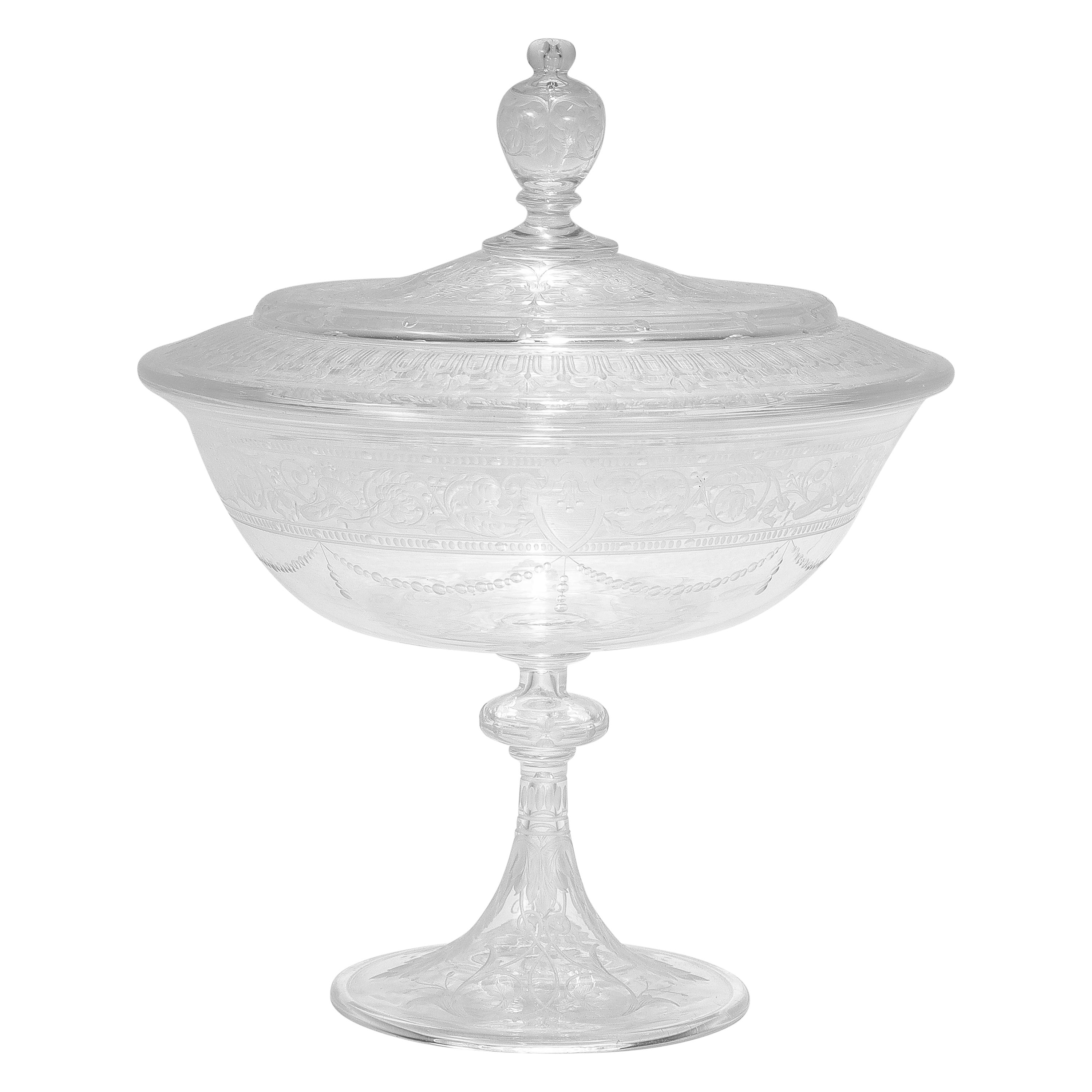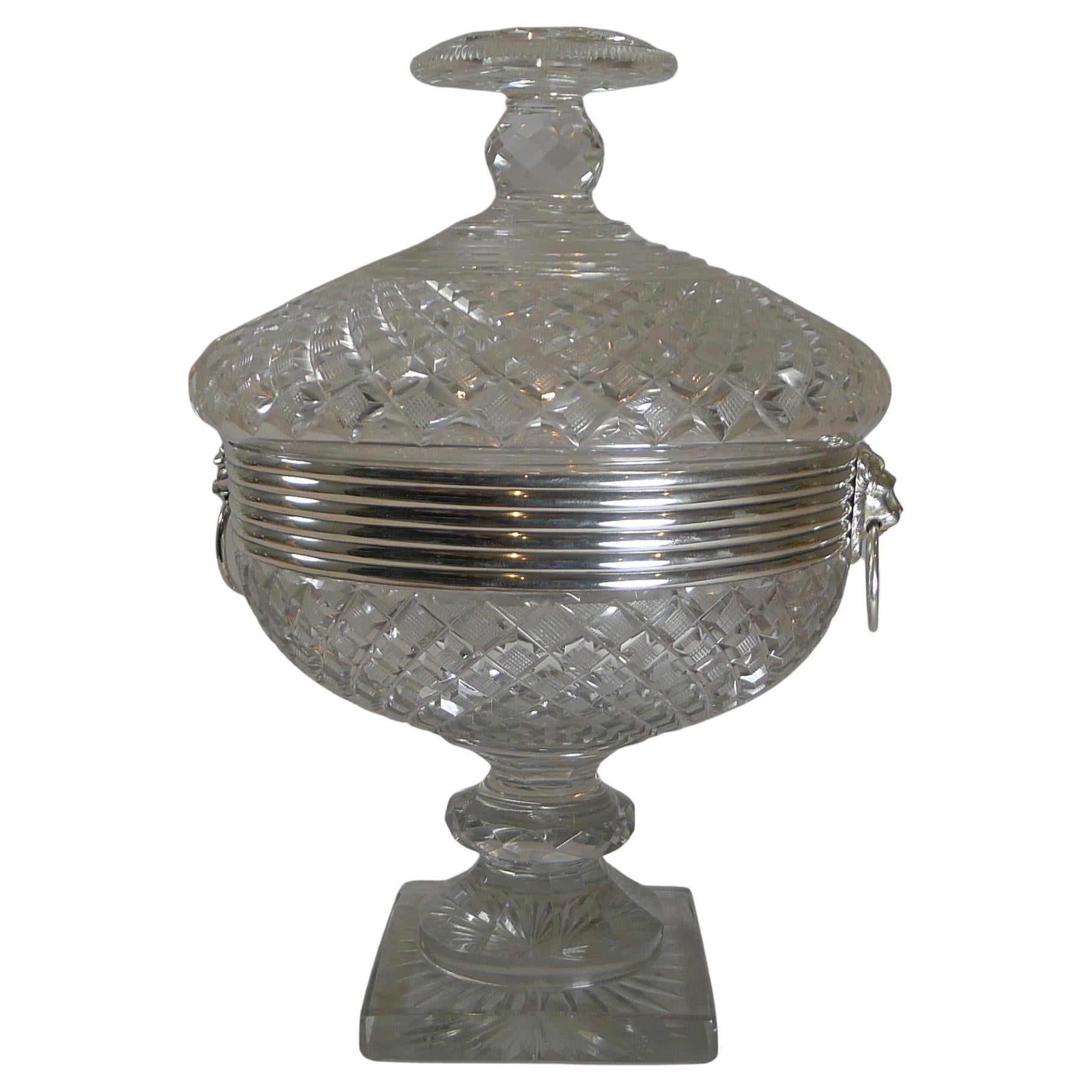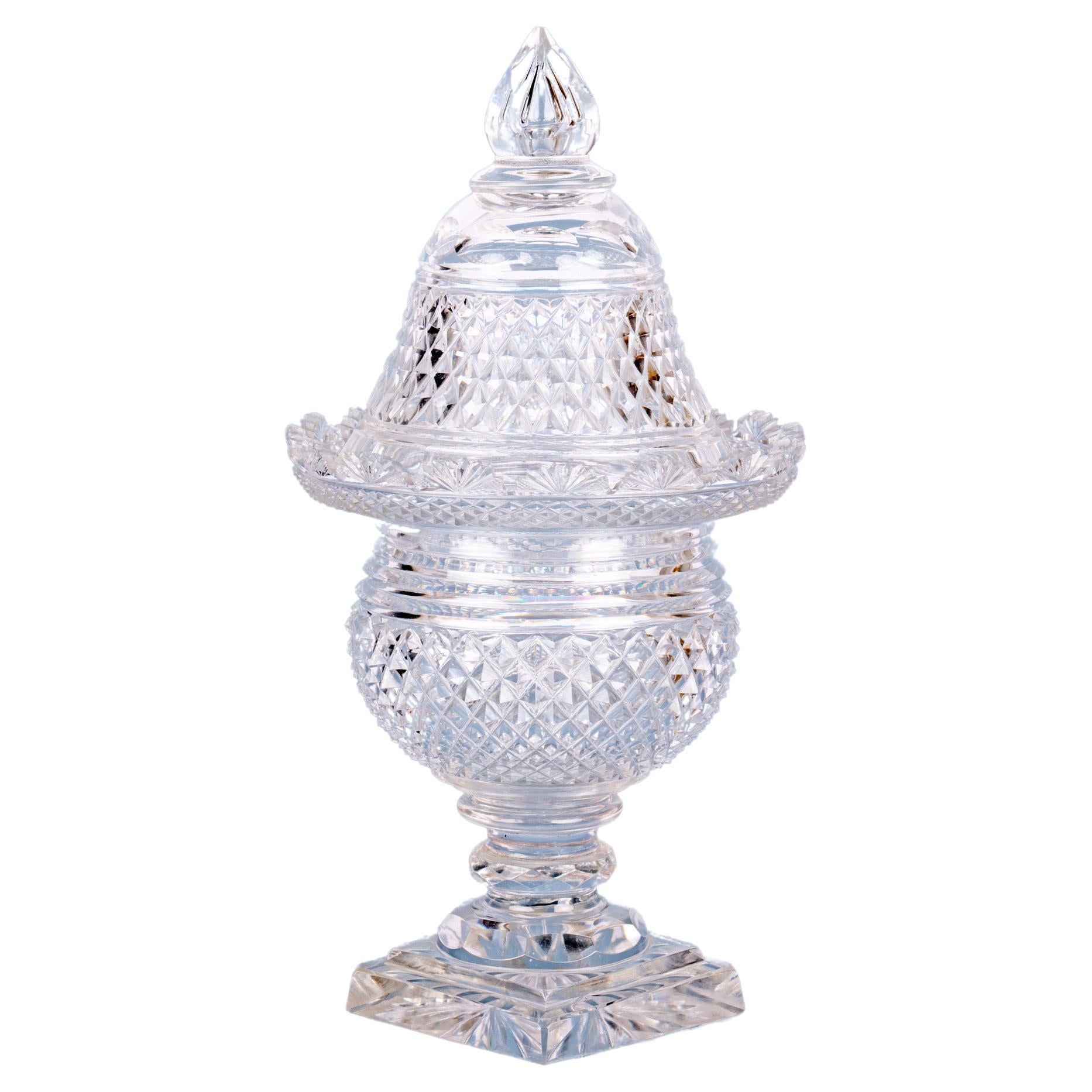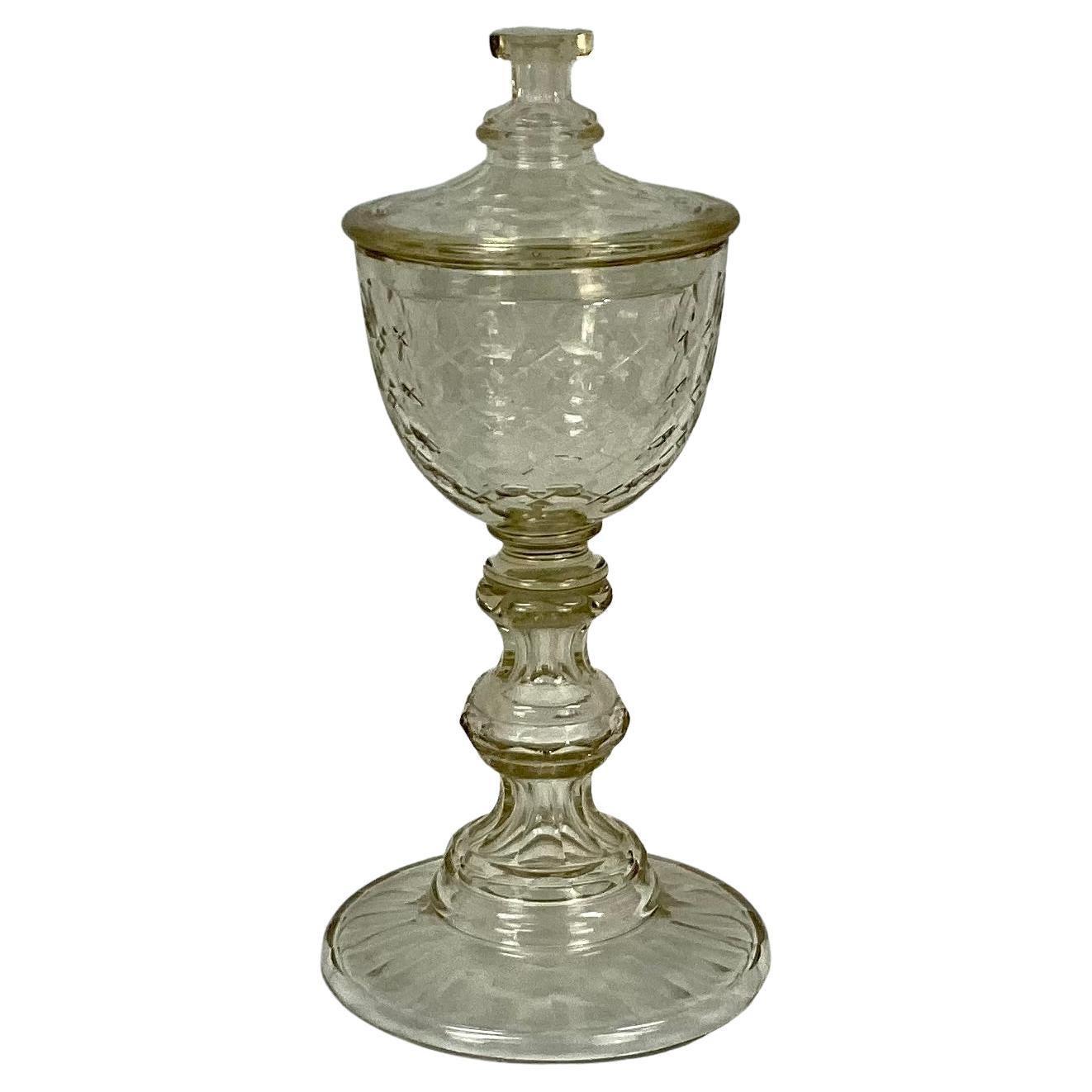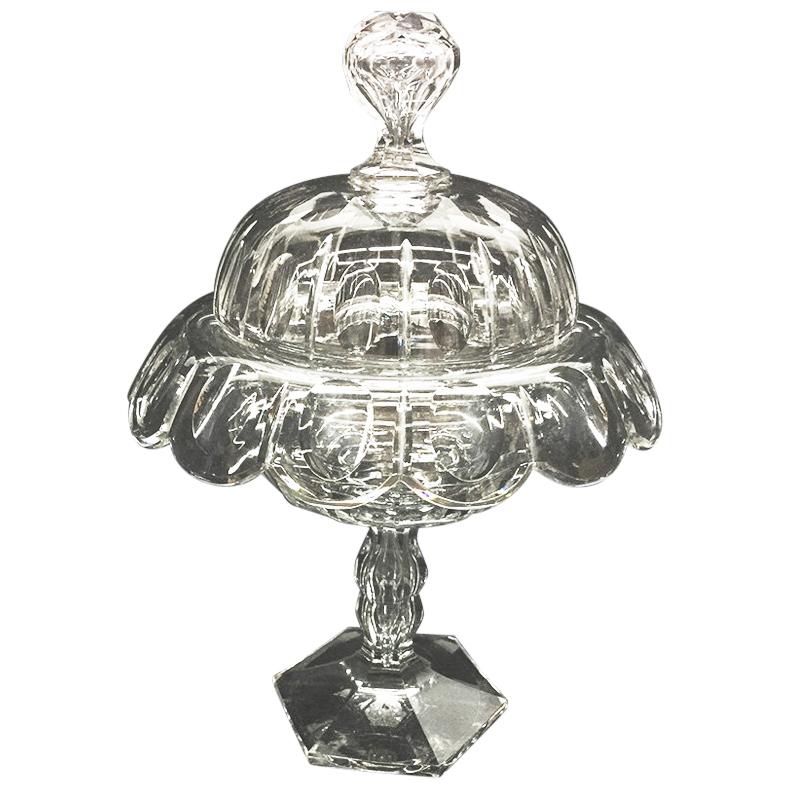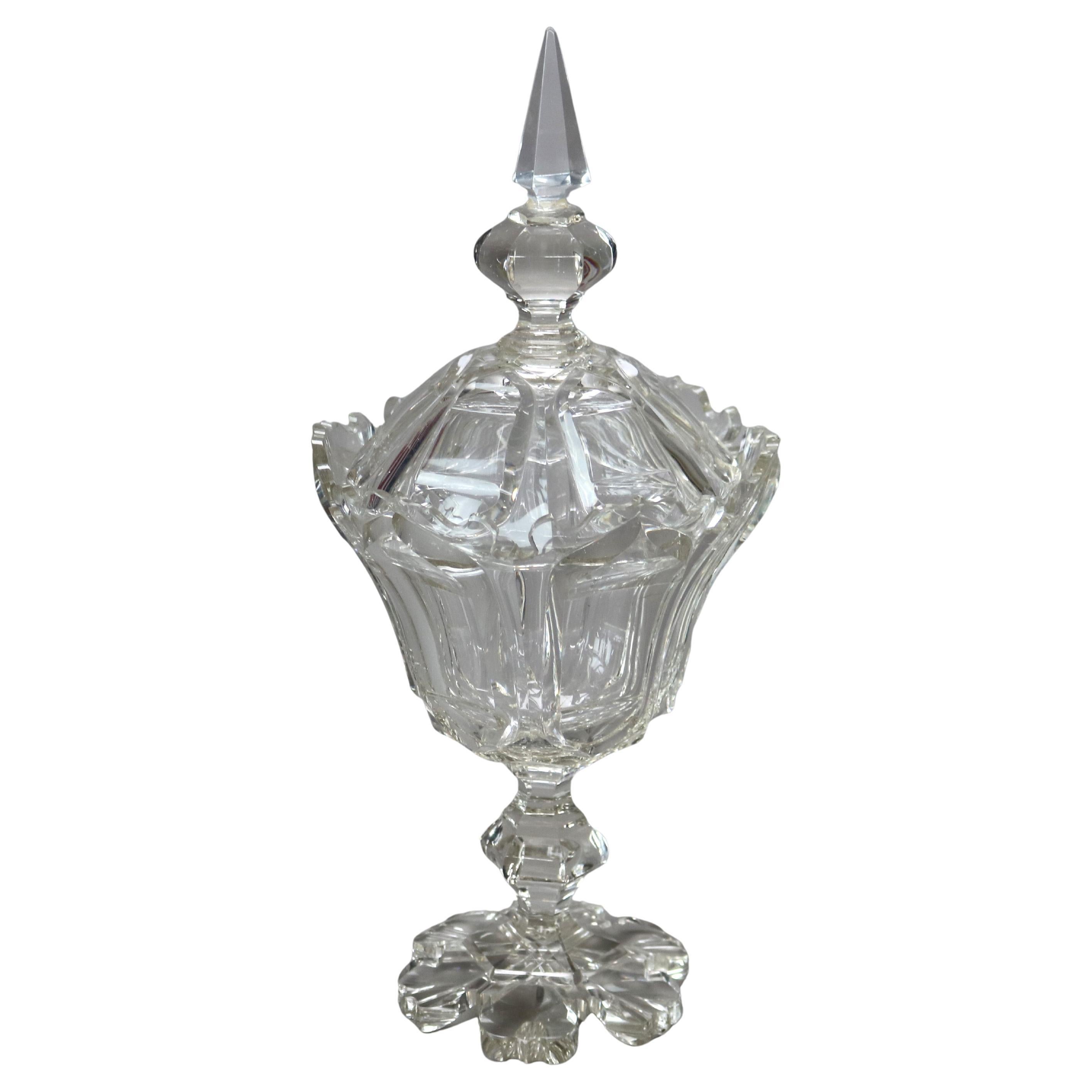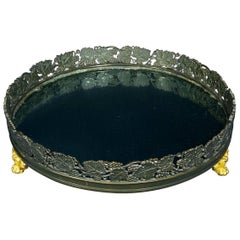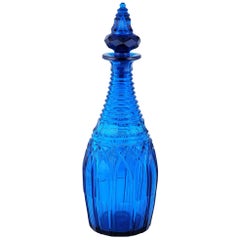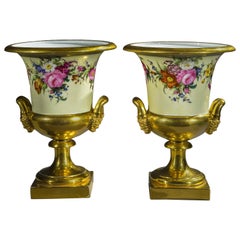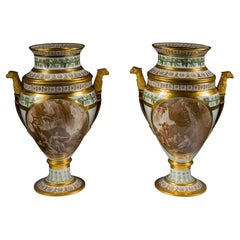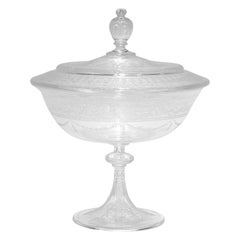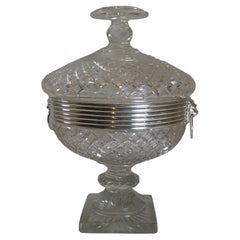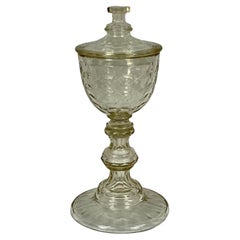Items Similar to Monumental Clear Cut-Glass Covered Compote
Want more images or videos?
Request additional images or videos from the seller
1 of 6
Monumental Clear Cut-Glass Covered Compote
$18,500
£13,970.46
€15,994.89
CA$26,126.84
A$28,524.25
CHF 14,954.10
MX$346,438.01
NOK 186,752.33
SEK 176,344
DKK 119,384.83
About the Item
Monumental clear cut-glass covered compote, circa 1820.
La Cristallerie de Vonêche (active 1802-30), Belgium.
Glass, blown and cut.
Measures: 17 3/8 in. high, 11 1/4 in. diameter.
Compotes, known in French as coupes à fruits were a mainstay in the line of tablewares produced by La Cristallerie de Vonêche. Offered in a variety of sizes and decorative patterns and with or without a foot, the cut decoration on the present compote features a pattern of repeated diamond points with flat surfaces that very frequently appeared on their stemware, tableware, and presentation pieces (see, for example, Norbert Bastin and Jacques Toussaint, Verrières et Cristalleries Namuroises Du XVIIIe Siecle a Nos Jours, exhib. cat. [Musee de Groesbeeck-de Croix, Namur, Belgium, 1985], pp. 68, fig. 114; 70, fig. 120; 115, fig. 262). This piece, however, stands apart from the lionshare of the compotes produced at Vonêche because of its unusually large scale.
La Cristallerie de Vonêche was actively producing glass from 1802 until 1830. Aimé Gabriel d’Artigues (1773-1848), the former Director of La Cristallerie Saint-Louis-lez-Biche, purchased La Verriere Sainte-Anne on June 1, 1802. He renovated and expanded the current premises to allow the production of pane glass, tableware, and presentation pieces, which had been largely abandoned by Sainte-Anne prior to their close earlier in 1802. In hopes of perfecting the science of producing the most beautiful glass products for 50 to 70% less money than what was currently being made, Vonêche actively experimented with lead, and other minerals. By 1810, Vonêche employed 600 to 700 workers. The fall of the French Empire just a few years later, however, took away a significant amount of their business from France, and they were forced to downsize.
Despite this turn of events, Vonêche remained a top producer of glass, continually attracting high level innovators in the development of the techniques of glass production to their staff. In 1830, the Belgian revolution presented serious economic challenges, and La Cristallerie de Vonêche was forced to close in December of that year. The lionshare of the staff moved to Namur, Liège, and Maastricht, and all of the materials and equipment at the factory were taken over by L. Zoude of Namur.
Condition: Perfect, except for a very small chip on the inside rim of the cover, which has been expertly and invisibly repaired.
- Dimensions:Height: 17.38 in (44.15 cm)Width: 11.25 in (28.58 cm)Depth: 11.25 in (28.58 cm)
- Style:Neoclassical (Of the Period)
- Materials and Techniques:
- Place of Origin:
- Period:
- Date of Manufacture:circa 1820
- Condition:Repaired. Condition: Perfect, except for a very small chip on the inside rim of the cover, which has been expertly and invisibly repaired.
- Seller Location:New York, NY
- Reference Number:Seller: FAPG 20189D1stDibs: LU90321931442
About the Seller
No Reviews Yet
Recognized Seller
These prestigious sellers are industry leaders and represent the highest echelon for item quality and design.
Established in 1952
1stDibs seller since 2010
Associations
Art Dealers Association of America
- ShippingRetrieving quote...Shipping from: New York, NY
- Return Policy
Authenticity Guarantee
In the unlikely event there’s an issue with an item’s authenticity, contact us within 1 year for a full refund. DetailsMoney-Back Guarantee
If your item is not as described, is damaged in transit, or does not arrive, contact us within 7 days for a full refund. Details24-Hour Cancellation
You have a 24-hour grace period in which to reconsider your purchase, with no questions asked.Vetted Professional Sellers
Our world-class sellers must adhere to strict standards for service and quality, maintaining the integrity of our listings.Price-Match Guarantee
If you find that a seller listed the same item for a lower price elsewhere, we’ll match it.Trusted Global Delivery
Our best-in-class carrier network provides specialized shipping options worldwide, including custom delivery.More From This Seller
View AllPlateau in the Restauration Taste with Grape and Leaf Motifs
Located in New York, NY
French.
Plateau in the Restauration taste with grape and leaf motifs, circa 1825.
Ormolu and patinated bronze, with mirror plate and wood backing.
Measures: 15 7/8 in. diameter, 3 11...
Category
Antique 1820s French Neoclassical Platters and Serveware
Materials
Bronze
Peacock Green Cut-Glass Decanter
Located in New York, NY
Peacock green cut-glass decanter
English, circa 1840.
Glass, blown and cut.
Measures: 13 1/2 in. high.
Condition: Perfect, except for minor flakes on the bottom of stopper.
Category
Antique 1840s English Neoclassical Glass
Materials
Glass
Pair of Medici-Form Vases
Located in New York, NY
Attributed to Schoelcher, Paris, France, circa 1830.
Porcelain, painted and gilded.
16 1/4 in. high, 9 1/2 in. wide, 9 1/2 in. deep.
Ex Coll.: by repute, Joseph Bonaparte...
Category
Antique Mid-19th Century French Empire Porcelain
Materials
Porcelain
$25,000 / set
Pair of Porcelain Urn Form Fruit Coolers with Covers and Liners
By Stône, Coquerel, and Legros d'Anisy
Located in New York, NY
Pair Footed Fruit Coolers, about 1810-20
Stône, Coquerel, and Legros D’Anisy, Paris (active 1808–49)
Porcelain, partially transfer printed in sepia and green and gilded
Each, 13 1/2 in. high x 10 in. wide x 7 1/2 in. deep
Signed and inscribed (on underside of one top and one base, with printed mark): STÔNE /
COQUEREL / ET / LE GROS / PARIS / PAR BREVET D’INVENTION: Manufre de Décors sur
Porcelaine Faience; variously inscribed with decorators’ initial in green and brown (on
underside of one top and one base): M; variously inscribed with incised mark (on underside of one liner and both bottoms): 3; inscribed (in blue script, on the inside of one liner): 615
The Parisian firm of Stône, Coquerel, and Legros d'Anisy is distinguished for the important role that it played in the introduction of transfer-printed decoration on fine china in France. Although the process had been known and used in Great Britain since the eighteenth century, it was, according to Régine de Plinval de Guillebon in her book, Porcelain of Paris 1770–1850 (New York: Walker and Company, 1972), not until 1802 that Potter, Blancheron, Constant, Neppel, Cadet de Vaux & Denuelle took out a patent in France for transfer-printing on earthenware, and it was only on February 26, 1808, that John Hurford Stône, his brother-in-law, Athanase Marie Martin Coquerel, and Francois Antoine Legros d'Anisy not only took out a patent for transfer-printing on china, but also established a Stône, Coquerel, and d'Anisy partnership for the manufacture of transfer-printed ceramics. Their address from 1808 until 1818 was at 9, rue de Cadran, Paris.
Prior to this, Stône and Coquerel had been partners at a creamware factory in Creil, France, and Legros d’Anisy had worked at the Sèvres factory, where he had apparently developed the transfer-printing technique for which his own firm became well known. “The process,” notes de Guillebon, was “based upon removing from the engraving a ‘pull’ made on a specially coated filter-paper, which was pressed onto the object to be decorated; this object itself was covered with a film. Firing took...
Category
Antique Early 19th Century French Neoclassical Wine Coolers
Materials
Porcelain
Regency Lantern
Located in New York, NY
English
Regency lantern, circa 1800.
Glass, blown, with gilt-brass fittings
27 in. high, 13 1/4 in. greatest diameter.
In a market that is overwhelmed with reproduction lanterns of ...
Category
Antique 19th Century English Regency Lanterns
Materials
Brass
$8,500
Pair of "Old Paris" Vases with Garlands of Bisquit Flowers
Located in New York, NY
French, circa 1820.
Porcelain, painted and gilded, with applied bisquit flowers
8 13/16 in. high.
Inscribed (with incised mark, under the base of each): 3.
Category
Antique 1820s French Neoclassical Porcelain
Materials
Porcelain
You May Also Like
Antique Stourbridge Etched & Engraved Glass Lidded Compote 1
By Stevens & Williams, William Fritsche, Thomas Webb & Sons
Located in Philadelphia, PA
A fine antique etched and engraved glass tazza or compote.
Attributed to Stevens & Williams or Webb.
With engraved & etched flowers, leaves, and geometric designs,
The lid i...
Category
Early 20th Century English Victorian Glass
Materials
Glass
Grand Cut Crystal & Dutch Silver Covered Sweet / Candy Bowl c.1880
Located in Bath, GB
An outstanding large covered bowl or dish made from heavy hand-cut crystal, a true grand centrepiece.
The Dutch silver mount is marked with the s...
Category
Antique 1880s Dutch Late Victorian Centerpieces
Materials
Crystal, Silver
$1,757 Sale Price
20% Off
Free Shipping
Regency Cut Glass Lidded Pedestal Jar
Located in Bishop's Stortford, Hertfordshire
A very fine antique cut glass jar and matching cover dating from around 1825. The jar stands on a thick square star cut based foot with a narrow slice cut stem and round bulbous body...
Category
Antique 1820s English Regency Glass
Materials
Cut Glass
19th Century Irish Cut Crystal Tall Compote with Lid
Located in Bradenton, FL
Tall Irish Glass compote with lid. Raised on a curved stemmed base with a goblet-style body featuring beautiful cut glass with matching lid. Excellent...
Category
Antique 19th Century Irish Belle Époque Glass
Materials
Glass
English 19th Century Crystal Lidded Coupe
Located in Delft, NL
An English 19th century crystal lidded coupe
An English crystal cut coupe with lid
The coupe raised on a hollow hand blown stem
The measurement of the...
Category
Antique 19th Century British Glass
Materials
Crystal
Antique Emhart Cut Glass Lidded Compote C1840
Located in Big Flats, NY
Antique Emhart Cut Glass Lidded Compote C1840
This exquisite antique Emhart cut glass lidded compote dates back to circa 1840. It features intricate cut glass detailing with a point...
Category
Antique Mid-19th Century Glass
Materials
Glass
More Ways To Browse
Sterling Flatware Set Monogrammed
Antique Glass Knife Rest
Antique Silver Canteen
Brass Salt And Pepper Shaker
Brass Salt And Pepper
Embroidered Napkins
Georg Jensen Sterling Ladle
Silver Plate Antique Fish Knives And Forks
Sterling Silver Flatware Service Set For 18
Toothpicks Silver
Appetizer Plate
Brass Flatware
Dansk Stainless
Silver Fish Service
Used Guillotines
1950 Vintage Salt And Pepper Shakers
Antique Ice Cream Forks
Oil Cruet
